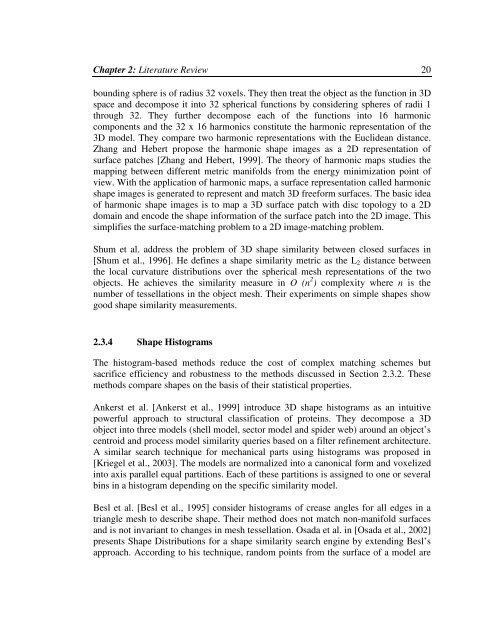To the Graduate Council: I am submitting herewith a thesis written by ...
To the Graduate Council: I am submitting herewith a thesis written by ...
To the Graduate Council: I am submitting herewith a thesis written by ...
Create successful ePaper yourself
Turn your PDF publications into a flip-book with our unique Google optimized e-Paper software.
Chapter 2: Literature Review 20bounding sphere is of radius 32 voxels. They <strong>the</strong>n treat <strong>the</strong> object as <strong>the</strong> function in 3Dspace and decompose it into 32 spherical functions <strong>by</strong> considering spheres of radii 1through 32. They fur<strong>the</strong>r decompose each of <strong>the</strong> functions into 16 harmoniccomponents and <strong>the</strong> 32 x 16 harmonics constitute <strong>the</strong> harmonic representation of <strong>the</strong>3D model. They compare two harmonic representations with <strong>the</strong> Euclidean distance.Zhang and Hebert propose <strong>the</strong> harmonic shape images as a 2D representation ofsurface patches [Zhang and Hebert, 1999]. The <strong>the</strong>ory of harmonic maps studies <strong>the</strong>mapping between different metric manifolds from <strong>the</strong> energy minimization point ofview. With <strong>the</strong> application of harmonic maps, a surface representation called harmonicshape images is generated to represent and match 3D freeform surfaces. The basic ideaof harmonic shape images is to map a 3D surface patch with disc topology to a 2Ddomain and encode <strong>the</strong> shape information of <strong>the</strong> surface patch into <strong>the</strong> 2D image. Thissimplifies <strong>the</strong> surface-matching problem to a 2D image-matching problem.Shum et al. address <strong>the</strong> problem of 3D shape similarity between closed surfaces in[Shum et al., 1996]. He defines a shape similarity metric as <strong>the</strong> L 2 distance between<strong>the</strong> local curvature distributions over <strong>the</strong> spherical mesh representations of <strong>the</strong> twoobjects. He achieves <strong>the</strong> similarity measure in O (n 2 ) complexity where n is <strong>the</strong>number of tessellations in <strong>the</strong> object mesh. Their experiments on simple shapes showgood shape similarity measurements.2.3.4 Shape Histogr<strong>am</strong>sThe histogr<strong>am</strong>-based methods reduce <strong>the</strong> cost of complex matching schemes butsacrifice efficiency and robustness to <strong>the</strong> methods discussed in Section 2.3.2. Thesemethods compare shapes on <strong>the</strong> basis of <strong>the</strong>ir statistical properties.Ankerst et al. [Ankerst et al., 1999] introduce 3D shape histogr<strong>am</strong>s as an intuitivepowerful approach to structural classification of proteins. They decompose a 3Dobject into three models (shell model, sector model and spider web) around an object’scentroid and process model similarity queries based on a filter refinement architecture.A similar search technique for mechanical parts using histogr<strong>am</strong>s was proposed in[Kriegel et al., 2003]. The models are normalized into a canonical form and voxelizedinto axis parallel equal partitions. Each of <strong>the</strong>se partitions is assigned to one or severalbins in a histogr<strong>am</strong> depending on <strong>the</strong> specific similarity model.Besl et al. [Besl et al., 1995] consider histogr<strong>am</strong>s of crease angles for all edges in atriangle mesh to describe shape. Their method does not match non-manifold surfacesand is not invariant to changes in mesh tessellation. Osada et al. in [Osada et al., 2002]presents Shape Distributions for a shape similarity search engine <strong>by</strong> extending Besl’sapproach. According to his technique, random points from <strong>the</strong> surface of a model are
















